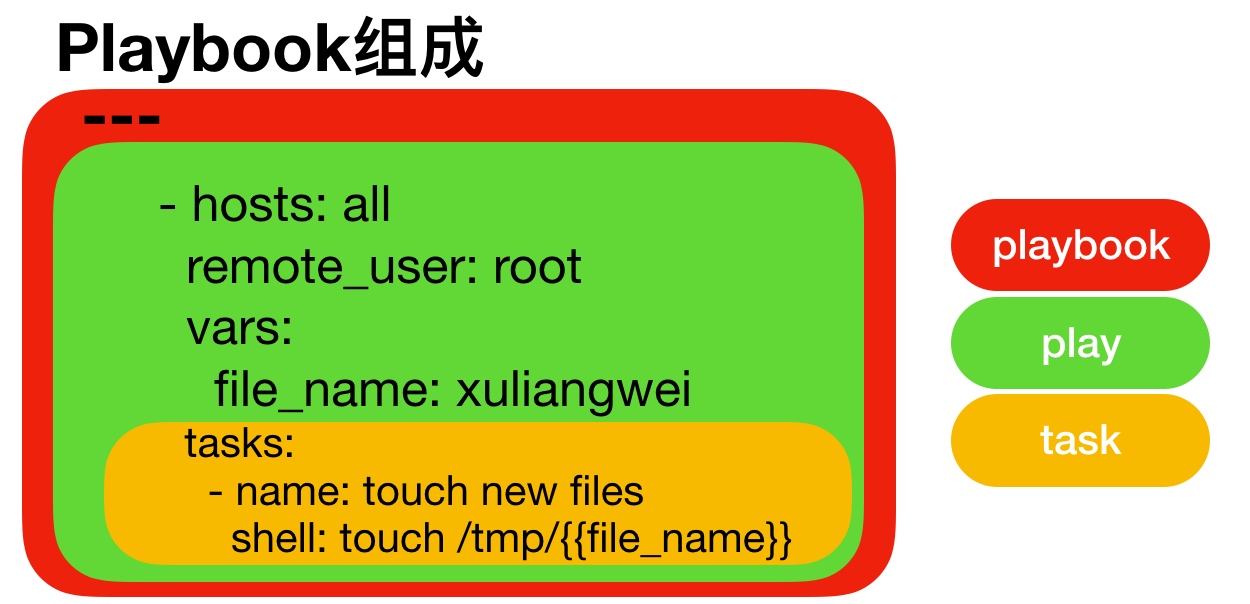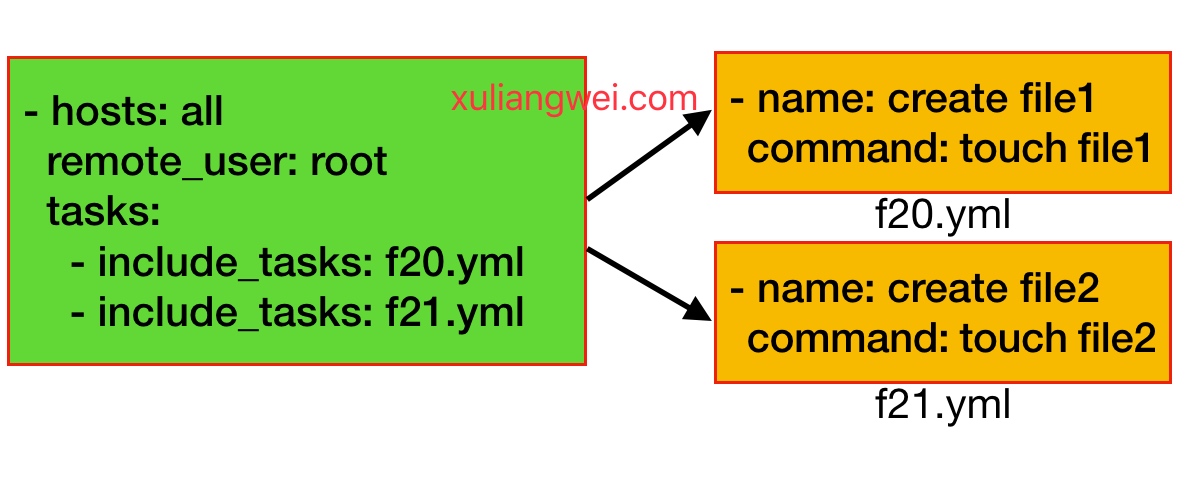Playbook剧本初识,剧本
Playbook剧本初识,剧本
目录
- 1.Playbook剧本初识
- 2.Playbook变量使用
- 3.Playbook变量注册
- 4.Playbook条件语句
- 5.Playbook循环语句
- 6.Playbook异常处理
- 7.Playbook tags标签
- 8.Playbook Handlers
- 9.Playbook Include
1.Playbook剧本初识
1.什么是playbook,playbook翻译过来就是“剧本”,那playbook组成如下
play: 定义的是主机的角色task: 定义的是具体执行的任务playbook: 由一个或多个play组成,一个play可以包含多个task任务
简单理解为: 使用不同的模块完成一件事情

2.playbook的优势
1.功能比ad-hoc更全2.能很好的控制先后执行顺序, 以及依赖关系3.语法展现更加的直观4.ad-hoc无法持久使用,playbook可以持久使用
3.playbook的配置语法是由yaml语法描述的,扩展名是yaml
- 缩进
- YAML使用固定的缩进风格表示层级结构,每个缩进由两个空格组成, 不能使用tabs
- 冒号
- 以冒号结尾的除外,其他所有冒号后面所有必须有空格。
- 短横线
- 表示列表项,使用一个短横杠加一个空格。
- 多个项使用同样的缩进级别作为同一列表。
#playbook示例
[root@manager ~]# cat f1.yml
---
- hosts: all
remote_user: root
vars:
file_name: xuliangwei
tasks:
- name: Create New File
file: name=/tmp/{{ file_name }} state=touch
#检查
ansible-playbook --syntax-check httpd.yml
#playbook执行方式
[root@manager ~]# ansible-playbook f1.yml
PLAY [all] ********************************************************************************************************************************
TASK [Gathering Facts] ********************************************************************************************************************
ok: [10.0.0.30]
TASK [使用变量] *******************************************************************************************************************************
changed: [10.0.0.30]
PLAY RECAP ********************************************************************************************************************************
10.0.0.30 : ok=2 changed=1 unreachable=0 failed=0Playbook执行结果返回颜色状态
红色: 表示有task执行失败或者提醒的信息
黄色:表示执行了且改变了远程主机状态
绿色:表示执行成功
2.Playbook变量使用
Playbook定义变量有三种方式
1) playbook的yaml文件中定义变量赋值
2) --extra-vars执行参数赋给变量
3) 在文件中定义变量
1、playbook的yaml文件中定义变量赋值
#playbook中定义
[root@manager ~]# cat f2.yml
- hosts: all
vars: #定义变量
file_name: bgx_yaml_vars
tasks:
- name: # {{ file_name }}引用上面定义的变量
file: path=/tmp/{{ file_name }} state=touch
#playbook执行,在/tmp目录创建bgx_yaml_vars文件
[root@manager ~]# ansible-playbook f1.yml2、--extra-vars执行参数赋给变量
#playbook中引用变量
[root@manager ~]# cat f3.yml
- hosts: all
tasks:
- name: Create New File
file: path=/tmp/{{ file_name }} state=touch
#playbook执行时传入file_name变量的参数,在/tmp目录创建bgx_extra-vars文件
[root@manager ~]# ansible-playbook f2.yml --extra-vars "file_name=bgx_extra-vars"3) 在文件中定义变量: 可以在/etc/ansible/hosts主机组中定义,然后使用palybook进行调度该变量
#在文件中定义变量
[root@manager ~]# cat /etc/ansible/hosts
[nfs]
10.0.0.20
[nfs:vars]
file_name=bgx_filename
#Playbook中调用该变量
[root@manager ~]# cat f4.yml
---
- hosts: all
tasks:
- name: Create New File
file: path=/tmp/{{ file_name }} state=touch
#playbook执行,在/tmp目录创建bgx_filename文件如果定义的变量出现重复,且造成冲突,优先级如下:
1.extra-vars外置传参的优先级最高 [所有执行的主机都生效]
2.定义在yml文件中的优先级其次 [所有执行的主机都生效]
3.hosts文件中定义的变量优先级最低 [当前主机组定义会生效]
3.Playbook变量注册
1) 注册变量: register关键字可以存储指定命令的输出结果到一个自定义的变量中
[root@manager ~]# cat f5.yml
---
- hosts: all
tasks:
- name:
shell: netstat -lntp
register: System_Status
- name: Get System Status
debug: msg={{System_Status.stdout_lines}}
#playbook执行结果
[root@manager ~]# ansible-playbook f5.yml
PLAY [all] ********************************************************************************************************************************
TASK [Gathering Facts] ********************************************************************************************************************
ok: [10.0.0.30]
TASK [shell] ******************************************************************************************************************************
changed: [10.0.0.30]
TASK [Get System Status] ******************************************************************************************************************
ok: [10.0.0.30] => {
"msg": [
"tcp 0 0 0.0.0.0:22 0.0.0.0:* LISTEN 925/sshd ",
"tcp6 0 0 :::22 :::* LISTEN 925/sshd "
]
}
PLAY RECAP ********************************************************************************************************************************
10.0.0.30 : ok=3 changed=1 unreachable=0 failed=04.Playbook条件语句
playbook中的条件判断语句使用when
[root@manager ~]# cat f6.yml
- hosts: all
remote_user: root
tasks:
- name: Create File
file: path=/tmp/this_is_{{ ansible_hostname }}_file state=touch
when: (ansible_hostname == "nfs") or (ansible_hostname == "backup")
#系统为centos的主机才会执行
- name: Centos Install httpd
yum: name=httpd state=present
when: (ansible_distribution == "CentOS")
#系统为ubuntu的主机才会执行
- name: Ubuntu Install httpd
yum: name=httpd2 state=present
when: (ansible_distribution == "Ubuntu")
#playbook执行结果:
[root@manager ~]# vim f6.yml
[root@manager ~]# ansible-playbook f6.yml
PLAY [all] ********************************************************************************************************************************
TASK [Gathering Facts] ********************************************************************************************************************
ok: [10.0.0.30]
TASK [Create File] ************************************************************************************************************************
skipping: [10.0.0.30] #主机名不匹配则跳过, 匹配则会进行创建文件
PLAY RECAP ********************************************************************************************************************************
10.0.0.30 : ok=1 changed=0 unreachable=0 failed=05.Playbook循环语句
1、标准循环使用场景-批量安装软件
[root@manager ~]# cat f7.yml
---
- hosts: all
remote_user: root
tasks:
- name: Installed Pkg
yum: name={{ item }} state=present
with_items:
- wget
- tree
- lrzsz
#palybook执行结果
[root@manager ~]# ansible-playbook f7.yml
PLAY [all] ********************************************************************************************************************************
TASK [Gathering Facts] ********************************************************************************************************************
ok: [10.0.0.30]
TASK [Installed Pkg] **********************************************************************************************************************
ok: [10.0.0.30] => (item=[u'wget', u'tree', u'lrzsz'])
PLAY RECAP ********************************************************************************************************************************
10.0.0.30 : ok=2 changed=0 unreachable=0 failed=02、标准循环使用场景-批量创建用户
[root@manager ~]# cat f7.yml
- hosts: all
remote_user: root
tasks:
- name: Add Users
user: name={{ item.name }} groups={{ item.groups }} state=present
with_items:
- { name: 'testuser1', groups: 'bin' }
- { name: 'testuser2', groups: 'root' }
#palybook执行结果
[root@manager ~]# ansible-playbook f7.yml
PLAY [all] ********************************************************************************************************************************
TASK [Gathering Facts] ********************************************************************************************************************
ok: [10.0.0.30]
TASK [Add Users] **************************************************************************************************************************
changed: [10.0.0.30] => (item={u'name': u'testuser1', u'groups': u'bin'})
changed: [10.0.0.30] => (item={u'name': u'testuser2', u'groups': u'root'})
PLAY RECAP ********************************************************************************************************************************
10.0.0.30 : ok=2 changed=1 unreachable=0 failed=03、标准循环使用场景-拷贝多个目录
[root@manager ~]# cat f7.yml
- hosts: all
remote_user: root
tasks:
- name: Configure Rsync Server
copy: src={{ item.src }} dest=/etc/{{ item.dest }} mode={{ item.mode }}
with_items:
- {src: "rsyncd.conf", dest: "rsyncd.conf", mode: "0644"}
- {src: "rsync.passwd", dest: "rsync.passwd", mode: "0600"}6.Playbook异常处理
默认Playbook会检查命令和模块的返回状态,如遇到错误就中断playbook的执行加入参数: ignore_errors: yes 忽略错误
[root@manager ~]# cat f9.yml
---
- hosts: all
remote_user: root
tasks:
- name: Ignore False
command: /bin/false
ignore_errors: yes
- name: touch new file
file: path=/tmp/bgx_ignore state=touchplaybook过程中会跳过错误
[root@manager ~]# ansible-playbook f9.yml
PLAY [all] ********************************************************************************************************************************
TASK [Gathering Facts] ********************************************************************************************************************
ok: [10.0.0.30]
TASK [Ignore False] ***********************************************************************************************************************
fatal: [10.0.0.30]: FAILED! => {"changed": true, "cmd": ["/bin/false"], "delta": "0:00:00.002819", "end": "2018-11-13 07:22:47.301758", "msg": "non-zero return code", "rc": 1, "start": "2018-11-13 07:22:47.298939", "stderr": "", "stderr_lines": [], "stdout": "", "stdout_lines": []}
...ignoring
TASK [touch new file] *********************************************************************************************************************
changed: [10.0.0.30]
PLAY RECAP ********************************************************************************************************************************
10.0.0.30 : ok=3 changed=2 unreachable=0 failed=07.Playbook tags标签
1、打标签
对一个对象打一个标签对一个对象打多个标签对多个对象打一个标签
2、标签使用,通过tags和任务对象进行捆绑,控制部分或者指定的task执行
-t: 执行指定的tag标签任务
--skip-tags: 执行--skip-tags之外的标签任务
[root@manager ~]# cat f10.yml
---
- hosts: all
remote_user: root
tasks:
- name: Install Nfs Server
yum: name=nfs-utils state=present
tags:
- install_nfs
- install_nfs-server
- name: Service Nfs Server
service: name=nfs-server state=started enabled=yes
tags: start_nfs-server
#正常执行playbook
[root@manager ~]# ansible-playbook f10.yml
PLAY [all] ********************************************************************************************************************************
TASK [Gathering Facts] ********************************************************************************************************************
ok: [10.0.0.30]
TASK [Install Nfs Server] *****************************************************************************************************************
ok: [10.0.0.30]
TASK [Service Nfs Server] *****************************************************************************************************************
ok: [10.0.0.30]
PLAY RECAP ********************************************************************************************************************************
10.0.0.30 : ok=3 changed=0 unreachable=0 failed=0使用-t指定tags执行, 多个tags使用逗号隔开即可
[root@manager ~]# ansible-playbook -t install_nfs-server f10.yml
PLAY [all] ********************************************************************************************************************************
TASK [Gathering Facts] ********************************************************************************************************************
ok: [10.0.0.30]
TASK [Install Nfs Server] *****************************************************************************************************************
ok: [10.0.0.30]
PLAY RECAP ********************************************************************************************************************************
10.0.0.30 : ok=2 changed=0 unreachable=0 failed=0使用--skip-tags排除不执行的tags
[root@manager ~]# ansible-playbook --skip-tags install_nfs-server f10.yml
PLAY [all] ********************************************************************************************************************************
TASK [Gathering Facts] ********************************************************************************************************************
ok: [10.0.0.30]
TASK [Service Nfs Server] *****************************************************************************************************************
ok: [10.0.0.30]
PLAY RECAP ********************************************************************************************************************************
10.0.0.30 : ok=2 changed=0 unreachable=0 failed=08.Playbook Handlers
playbook安装Apache示例
[root@m01 ~]# cat webserver.yml
- hosts: web
remote_user: root
#1.定义变量,在配置文件中调用
vars:
http_port: 8881
#2.安装httpd服务
tasks:
- name: Install Httpd Server
yum: name=httpd state=present
#3.使用template模板,引用上面vars定义的变量至配置文件中
- name: Configure Httpd Server
template: src=./httpd.conf dest=/etc/httpd/conf/httpd.conf
notify: Restart Httpd Server
#4.启动Httpd服务
- name: Start Httpd Server
service: name=httpd state=started enabled=yes
#5.检查Httpd服务当前的运行的端口状态
- name: Get Httpd Server Port
shell: netstat -lntp|grep httpd
register: Httpd_Port
#6.输出Httpd运行的状态至面板
- name: Out Httpd Server Status
debug: msg={{ Httpd_Port.stdout_lines }}
ignore_errors: yes
#6.如果配置文件发生变化会调用该handlers下面的模块
handlers:
- name: Restart Httpd Server
service: name=httpd state=restarted9.Playbook Include
include用来动态的包含tasks任务列表,include_tasks新版/include老版

include调用任务方式
#主入口文件
[root@mha ~]# cat main.yml
- hosts: all
remote_user: root
tasks:
- include_tasks: f20.yml
- include_tasks: f21.yml
#f20.yml
[root@mha ~]# cat f20.yml
- name: create file1
command: touch file1
#21.yml
[root@mha ~]# cat f21.yml
- name: create file2
command: touch file2
评论暂时关闭